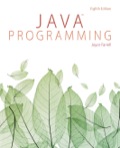
Concept explainers
Explanation of Solution
Program code:
Card.java
//create a class Card
public class Card
{
//declare class variables
private static char suit;
private static int value;
//define a class method getSuit()
public static char getSuit()
{
//return the value of suit
return suit;
}
//define a class method setSuit()
public static void setSuit(char suit)
{
//set the value of suit
Card.suit = suit;
}
//define a class method getValue()
public static int getValue()
{
//return the value of value
return value;
}
//define a class method setValue()
public static void setValue(int value)
{
//set the value of value
Card.value = value;
}
}
Explanation:
The above snippet of code is used to create a class “Card”. In the code,
- Import the required header files.
- Define a class “Card”
- Declare the class variables “suit” and “value”.
- Define the “getSuit()” method.
- Return the value of “suit”
- Define the “setSuit()” method.
- Set the value of “suit”
- Define the “getValue()” method.
- Return the value of “value”
- Define the “setValue()” method.
- Set the value of “value”
PickTwoCards.java
//import the required files
import java.util.Random;
//define a class PickTwoCards
public class PickTwoCards
{
//declare class member variables
final static int CARDS_IN_SUIT = 13;
final static char[] suits = {'s','h','d','c'};
//define the main() method
public static void main(String args[])
{
//create the object of class Card
Card firstCardSelected = selectACard();
//print the statement
System.out.println("Your FIRST Card is Selected with::");
System.out.println("********************************");
//call the method getSuit()
System.out.println("Suit ::"+firstCardSelected.getSuit());
//call the method getValue()
System.out.println("Value ::"+firstCardSelected.getValue()+"\n");
//create the object of class Card
Card secondCardSelected = selectACard();
//print the statement
System.out.println("Your SECOND Card is Selected with::");
System.out.println("********************************");
//call the method getSuit()
System.out.println("Suit ::"+secondCardSelected.getSuit());
//call the method getValue()
System.out.println("Value ::"+secondCardSelected.getValue()+"\n");
}
//define a method selectACard()
public static Card selectACard()
{
//create the object of class Card
Card card = new Card();
//call the method setSuit()
card...
Trending nowThis is a popular solution!

Chapter 3 Solutions
EBK JAVA PROGRAMMING
- "Do not use AI tools. Solve the problem by hand on paper only and upload a photo of your handwritten solution."arrow_forward"Do not use AI tools. Solve the problem by hand on paper only and upload a photo of your handwritten solution."arrow_forward"Do not use AI tools. Solve the problem by hand on paper only and upload a photo of your handwritten solution."arrow_forward
- "Do not use AI tools. Solve the problem by hand on paper only and upload a photo of your handwritten solution."arrow_forwardSolve this "Do not use AI tools. Solve the problem by hand on paper only and upload a photo of your handwritten solution."arrow_forward"Do not use AI tools. Solve the problem by hand on paper only and upload a photo of your handwritten solution."arrow_forward
- "Do not use AI tools. Solve the problem by hand on paper only and upload a photo of your handwritten solution."arrow_forwardSpecifications: Part-1Part-1: DescriptionIn this part of the lab you will build a single operation ALU. This ALU will implement a bitwise left rotation. Forthis lab assignment you are not allowed to use Digital's Arithmetic components.IF YOU ARE FOUND USING THEM, YOU WILL RECEIVE A ZERO FOR LAB2!The ALU you will be implementing consists of two 4-bit inputs (named inA and inB) and one 4-bit output (named out). Your ALU must rotate the bits in inA by the amount given by inB (i.e. 0-15).Part-1: User InterfaceYou are provided an interface file lab2_part1.dig; start Part-1 from this file.NOTE: You are not permitted to edit the content inside the dotted lines rectangle. Part-1: ExampleIn the figure above, the input values that we have selected to test are inA = {inA_3, inA_2, inA_1, inA_0} = {0, 1, 0,0} and inB = {inB_3, inB_2, inB_1, inB_0} = {0, 0, 1, 0}. Therefore, we must rotate the bus 0100 bitwise left by00102, or 2 in base 10, to get {0, 0, 0, 1}. Please note that a rotation left is…arrow_forwardSolve this "Do not use AI tools. Solve the problem by hand on paper only and upload a photo of your handwritten solution."arrow_forward
- Solve this "Do not use AI tools. Solve the problem by hand on paper only and upload a photo of your handwritten solution."arrow_forward"Do not use AI tools. Solve the problem by hand on paper only and upload a photo of your handwritten solution."arrow_forwardSolve this "Do not use AI tools. Solve the problem by hand on paper only and upload a photo of your handwritten solution."arrow_forward
 EBK JAVA PROGRAMMINGComputer ScienceISBN:9781337671385Author:FARRELLPublisher:CENGAGE LEARNING - CONSIGNMENTProgramming Logic & Design ComprehensiveComputer ScienceISBN:9781337669405Author:FARRELLPublisher:Cengage
EBK JAVA PROGRAMMINGComputer ScienceISBN:9781337671385Author:FARRELLPublisher:CENGAGE LEARNING - CONSIGNMENTProgramming Logic & Design ComprehensiveComputer ScienceISBN:9781337669405Author:FARRELLPublisher:Cengage EBK JAVA PROGRAMMINGComputer ScienceISBN:9781305480537Author:FARRELLPublisher:CENGAGE LEARNING - CONSIGNMENT
EBK JAVA PROGRAMMINGComputer ScienceISBN:9781305480537Author:FARRELLPublisher:CENGAGE LEARNING - CONSIGNMENT Microsoft Visual C#Computer ScienceISBN:9781337102100Author:Joyce, Farrell.Publisher:Cengage Learning,
Microsoft Visual C#Computer ScienceISBN:9781337102100Author:Joyce, Farrell.Publisher:Cengage Learning, Programming with Microsoft Visual Basic 2017Computer ScienceISBN:9781337102124Author:Diane ZakPublisher:Cengage Learning
Programming with Microsoft Visual Basic 2017Computer ScienceISBN:9781337102124Author:Diane ZakPublisher:Cengage Learning




